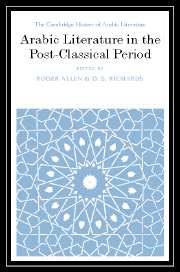18 - Pre-modern drama
from Part V - Drama
Published online by Cambridge University Press: 28 March 2008
Summary
Drama was not unknown to Arab society when the beys of Tunis and the French expeditionary force brought European theatrical performances to the area in the late eighteenth century. Traditional forms of popular drama continued to exist well after the growth of European dramatic activities in the Arab world and were to provide some inspiration to the emergent modern Arab theatre. Apart from a number of texts of shadow theatre our limited knowledge of this whole genre depends largely upon the accounts of travellers and local chroniclers. The Arab elite excluded Arabic drama from their concept of the realm of literature, because pre-modern theatrical performances were oral, given in colloquial or semi-colloquial, and provided what was regarded as frivolous, impudent and debauched (sukhf wa-mujūn) entertainment. Thus the literary tradition refers to this drama only in casual allusions.
karākūz
In the nineteenth century most visitors to any town in North Africa, Iraq and the Levant would have seen the ‘ludicrous exhibition of rude jests, bear-fighting, unseemly gestures’, represented in shadow or puppet theatre by two fantastically dressed personages, Karākūz and ‘Īwāz. They might also have witnessed one of the many groups of itinerant performers of comic improvisatory drama, variously called halqa, bisāt, hābābziya, Awlād Rābiya or sāmir. Shadow theatre (Karākūz or khayāl al-zill) portrayed characters reflected as shadows cast by flat, coloured puppets on a white linen screen. The shadow-player frequently used a stand, like the European marionette theatre, with a screen stretched across and illuminated from behind by an oil-lamp or candles.
- Type
- Chapter
- Information
- Arabic Literature in the Post-Classical Period , pp. 369 - 384Publisher: Cambridge University PressPrint publication year: 2006
References
- 1
- Cited by



